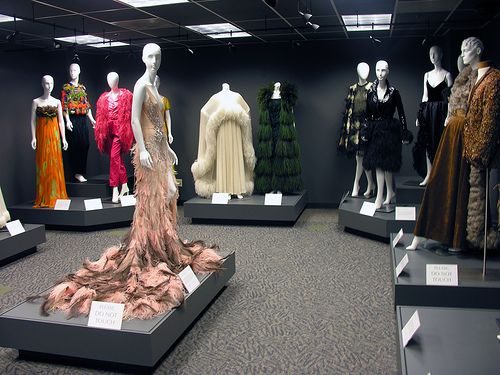On a national level, it provided designer ensembles for an inaugural exhibition, Picturing French Style: Three Hundred Years of Art and Fashion at Alabama’s Mobile Museum of Art. “The TFC has produced a broad range of exhibitions during the past fifteen years. Everyone cannot make constant trips to New York to see the latest historical fashion exhibition. So, we have done our best to bring those high standards to the public,” says Walker.
What lies beneath the overall importance of the Collection is the well-rounded vision of the various fashion designers represented. In a world where an overnight-sensation clothing designer takes on the role of rock star status, the great designers of yesteryear built reputations mostly through word of mouth from their loyal clientele and their commitment to putting a unique stamp on their couture creations.
Cristobal Balanciaga, whose designs rivaled the elegance of Christian Dior’s New Look of the 1940s and ‘50s and into the mod ‘60s, has an impressive presence at the Collection. Referred to as the master of 20th-century fashion design, Balenciaga’s tutelage as a tailor and the cultural stimulation of his native Spain were significantly reflected in his work. Unraveling women from the constraining facets of made-to-measure design, he emphasized clothing that was correct in proportion and fit, implemented in fabrics that held their shape with minimal seams and darts. The Collection reflects the best of his work from 1952 – 1968 and consists of 319 examples of his most significant creations for both daytime and evening, including 86 dresses, 27 suits and 42 coats and numerous hats. All offer a glimpse of the jet set world of fashion during its most glittering era.
When one thinks of Hubert de Givenchy, one pictures the timeless style of actress Audrey Hepburn, for whom he designed both on and off screen. A legion of International Best Dressed List women wore his clothes with pride. He opened the House of Givenchy in 1952 after working with Balenciaga and Elsa Schiaparelli and soon attracted as patrons some of the most captivating style setters of the century. Givenchy’s designs combined flawless craftsmanship and polished sophistication. His clean lines, vibrant colors and consistently ladylike garments influence designers to this day. Several interpretations of his “Hepburn look” were to be seen on the catwalks in recent Spring collections. While maintaining one of the most successful couture houses for five decades, Givenchy also obtained lucrative licensing contracts for clothing, scents and cosmetics. The Texas Fashion Collection has 203 pieces of his best work from 1955 through his retirement in 1995, including 98 dresses, 34 suits, 21 coats, and 50 ensembles.
Oscar de la Renta’s works in the Collection, show how his life as a leader of the world’s stylish elite influenced his designs. After stints in Spain with Balenciaga and Anthony Castillio, this Dominican Republic native landed in New York in 1963 to design for Elizabeth Arden couture and ready-to-wear. Finding rapid success, he formed his own namesake company; in the late 1960s his Russian and gypsy-inspired creations igniting a new fire in the design world. While the ‘70s saw an explosion of success with his own range of contemporary to high-end couture fashions, he also designed for the Pierre Balmain couture label in Paris. Texan Mercedes Bass was among his glamorous clients, who included the most celebrated beauties in the world. The Collection features 55 de la Renta designs (34 dresses, seven suits, three coats, along with two daytime ensembles and nine for evening). The work spans from 1978 to 1994, with additional pieces listed under the Pierre Balmain label.
Norman Norell is the ultimate example of The Great American Designer. After working briefly as a costume designer for the Astoria Studio of Paramount Pictures at age 22, Norell spent the next 12 years with fellow legend, Hattie Carnegie, the mother of modern sportswear, gaining priceless experience in retail, wholesale, and custom fashion design. His regular trips to Paris with Carnegie provided the inspiration to create his own style. Norell’s first collection, for Traina-Norell, debuted in 1941. Ultimately he formed his own label, which remained in the forefront of significant American fashion for the rest of his career. Known for his understated simple wool dresses with high round necklines, sequined cocktail dresses and sailor motifs, Norell was adored by women around the world (Former Dallasite and MGM movie star Greer Garson was a devotee of his aesthetic). His career is represented in the Collection with 124 designs. Norman Norell’s 83 dresses, 14 suits, and 23 ensembles span the period between 1940 and 1972, and are considered some of the organization’s most stellar holdings.
Myra Walker describes the Collection as “truly awesome.” She explains, “Texans always go on about being the biggest or the best. We are not the largest collection in the country. But we are one of the very best and we happen to be right here.” The Texas Fashion Collection confirms that integrity in style is a way of life for American women, especially those in Texas. The next time you see a new designer gown, think about what you are seeing. Will it someday be worthy of donation to a fashion collection of this caliber? There’s always room for consistent elegance in a fashionable life: one that goes behind the seams.



